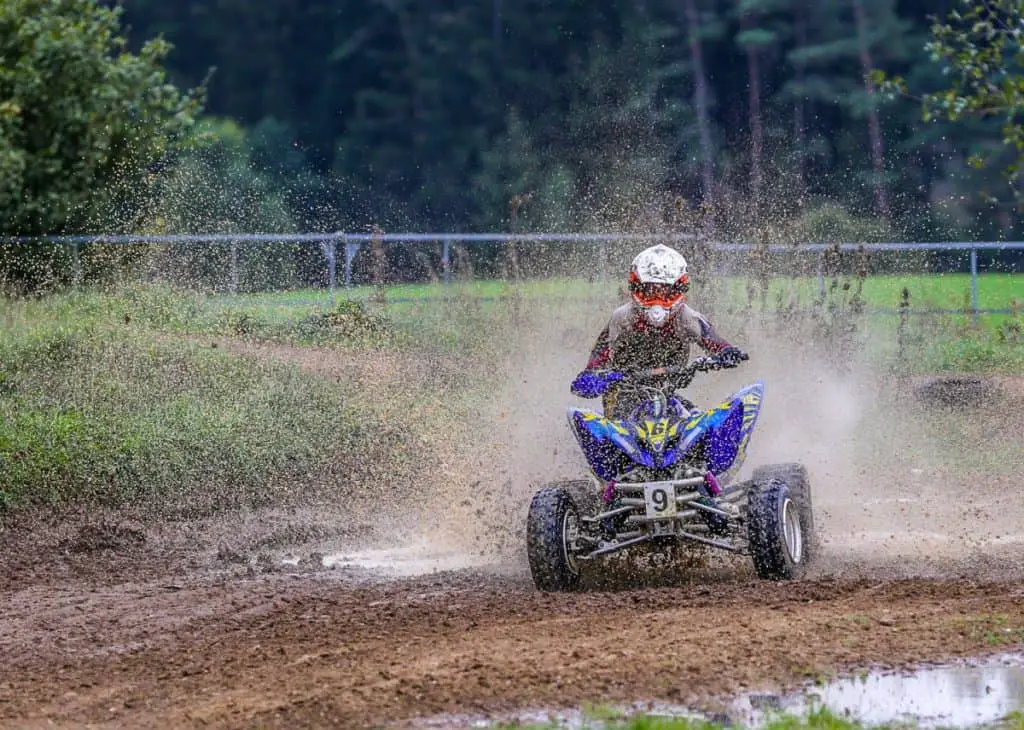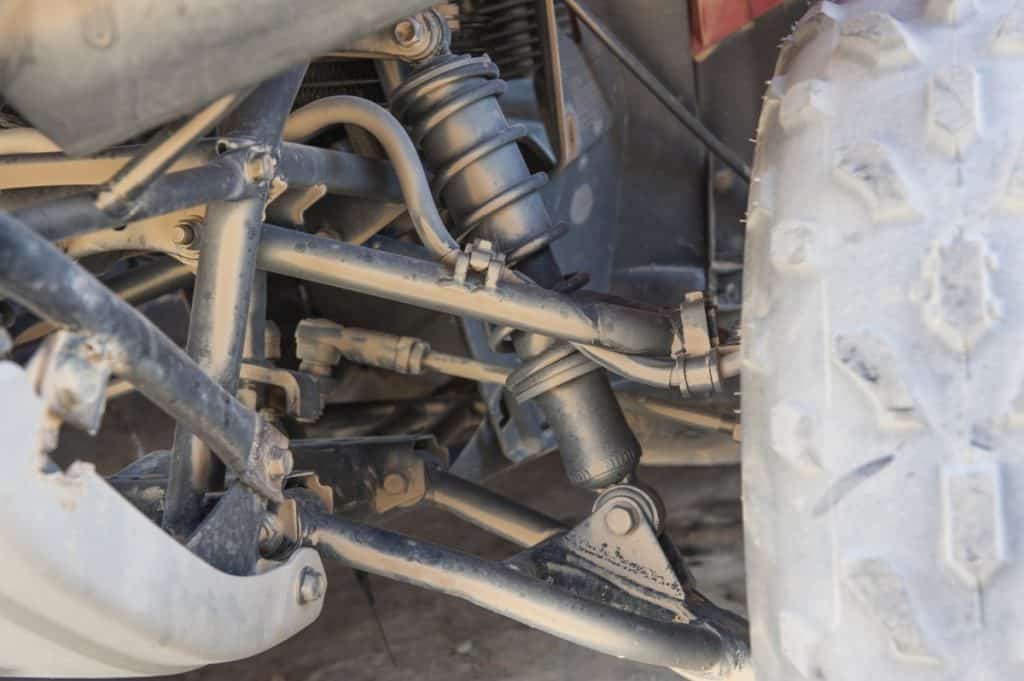Shocks aren’t as noticeable as a tire being flat, or the starter motor not working yet it’s very important to have your ATV shocks in good condition. Because of that, it’s important to be able to identify when your ATV shocks are bad. Here’s a summary of the warning signs that indicate they are bad and should be looked at.
When you notice the nose dive when braking, the body tilting sideways in one or both directions as you turn, the ride feels more harsh and bumpy than normal, the rear sags when you accelerate, you have less traction than normal are all signs your ATV shocks are bad.
Shocks, and the springs they connect to, get worse slowly over time. Because of this fact, you can be unaware of an issue with your shocks because it developed so slowly. With that said if you take note of each of these signs then notice next time you ride your ATV for any of these symptoms you will be able to identify if there’s an issue.

Multiple Symptoms Indicate Your ATV Shocks or Springs Are Bad
It’s possible that your ATV will only have one sign that the shocks or springs are bad but it can show multiple. The symptoms are:
- Nose diving when braking
- Body tilting (side to side)
- The ride feels harsh – bumpier than before
- When you accelerate the rear sags
- The rear axle bottoms out when you go over a bump
- Swerve – you need to turn harder than normal when turning
Before explaining what to look for, for each of these symptoms, it’s important to first understand that the shocks are attached to the top of the springs. The springs of ATVs are the big metal coil you can typically see. The springs can be adjusted so they are tighter or looser.
The springs can be loose or tight and simply need to be adjusted. In the owner’s manual of ATVs, it lists the exact specifications for the tightness and height of the springs. To understand this better here’s a really good video that shows the anatomy of ATV shocks and springs so you know how to see if the springs simply need adjusting.
Note: It goes into a bit of jargon and seems a bit complicated but simply put there’s a large screw that you wind up or down to adjust the spring height.
Nose diving when braking – front shocks/springs are bad
The weight of the ATV moves forward when you brake due to the tires being positioned at the bottom of an ATV. There will be a minor amount of nose-diving if you brake hard at high speeds but if it seems to have gotten worse. And/or it’s more noticeable, then it indicates that the front shocks or springs are bad.
Body tilt – the body leans to one side when you corner
As you corner the body of your ATV it will dip to the far side. For example, if you turn right the body will lean to the left. And if you’re turning left it will lean to the right. This is due to the weight of the ATV not being kept up with the shocks or springs. Instead of holding the body rigid the shocks or springs give too much.
The ride is bumpier and not as smooth and comfortable
This one can be difficult to detect because it occurs gradually over time. However, the shocks/springs can be broken or have come loose suddenly. In this case, it will be much more noticeable.
When you accelerate the rear becomes lower
Accelerating on shocks that aren’t performing correctly or the springs have come loose causes the rear of the ATV to dip low, and the front to come up slightly. This causes a loss of traction in the front wheels which is undesirable. And leads steering is not as responsive.
It’s pretty easy to notice this one especially when it occurs when you accelerate slowly. It can help to watch videos of people riding your ATV model to see what amount of rear sag is normal.

The read axle bottoms out when you go over a bump
If you encounter speed bumps, or a similar type of road condition in off-roading, a sign the shocks or springs need replacing or adjusting is if the rear bottoms out. The rear wheels come much closer to the wheel hub than looks or feels normal.
Swerve – you need to turn harder than normal when turning
As an ATV or other vehicle with 4 wheels corners the shocks/springs on the far side will keep the body perfectly flat. This is another way to tell if the ATV is experiencing body tilt but is easier to identify if you’re riding your ATV.
If the shocks are not performing correctly as you corner the ATV will dip to the side and put additional pressure on the far side wheels. Making it more difficult to turn. You will need to turn sharper than you needed to when you first got it.
The reason is the force of the weight of the ATV is concentrated more on the outside tires. Rather than being spread evenly between all four tires.
In the owner’s manual of popular ATVs like the Polaris Sportsman, it’s recommended to inspect the shocks every time before you ride. Any signs of leakages around the shocks indicate an issue.
Also, it’s best practice to clear away any twigs, leaves, or anything else stuck in the shocks. They also recommend to thoroughly inspecting and adjusting them every 50 hours of riding, after 6 months, or after 500 miles or 800 km, whichever comes first.
The owner’s manual doesn’t list any specific checks to do, in my opinion, you should have them checked over by a mechanic as part of the service.
Another part of an ATV that will eventually experience issues is the clutch. In another article, I explained how to know when an ATV clutch is bad and when it needs to be serviced or replaced.

How Do You Stiffen ATV Shocks?
When riding your ATV you can feel like the shocks are a bit bouncy and you would be more comfortable if the shocks didn’t have so much give in them. Here’s how to adjust the ATV shocks so they’re stiffer.
Adjust the height of the spring so that it’s shorter to stiffen ATV shocks. This is done by adjusting what is called the preload. Every ATV has a stock spring height virtually always listed in the owner’s manual. From the stock spring height make the spring shorter by adjusting it to your liking.
One issue when the spring is shorter is you can get more rebound. This is because the spring is under more tension. When you go over bumps it will bounce back more which can be a bit uncomfortable.
It’s also not possible to adjust the spring height on some ATVs. In the owner’s manual see if they provide any guidelines about how much you can adjust the spring height from the stock height. And if in doubt contact your ATV manufacturer to enquire about whether it’s OK to do on your specific make and model.
How Can I Make My ATV Suspension Softer?
The suspension on an ATV can be a bit stiff. Softening the suspension makes it more comfortable. So here’s how to make the suspension on an ATV softer.
The height of the spring can be increased. This will cause the spring to be under less tension and make the suspension softer. The owner’s manual will list the recommended spring height. Start with that and increase it a small amount at a time until it’s to your liking.
It’s important to only adjust it as much as it needs, as the springs are designed to provide proper suspension within a height range. If you’re unsure or would rather have a professional do it, then contact the nearest dealer for your ATV. Or, your nearest motorcycle/ATV mechanic to have them adjust it for you.

